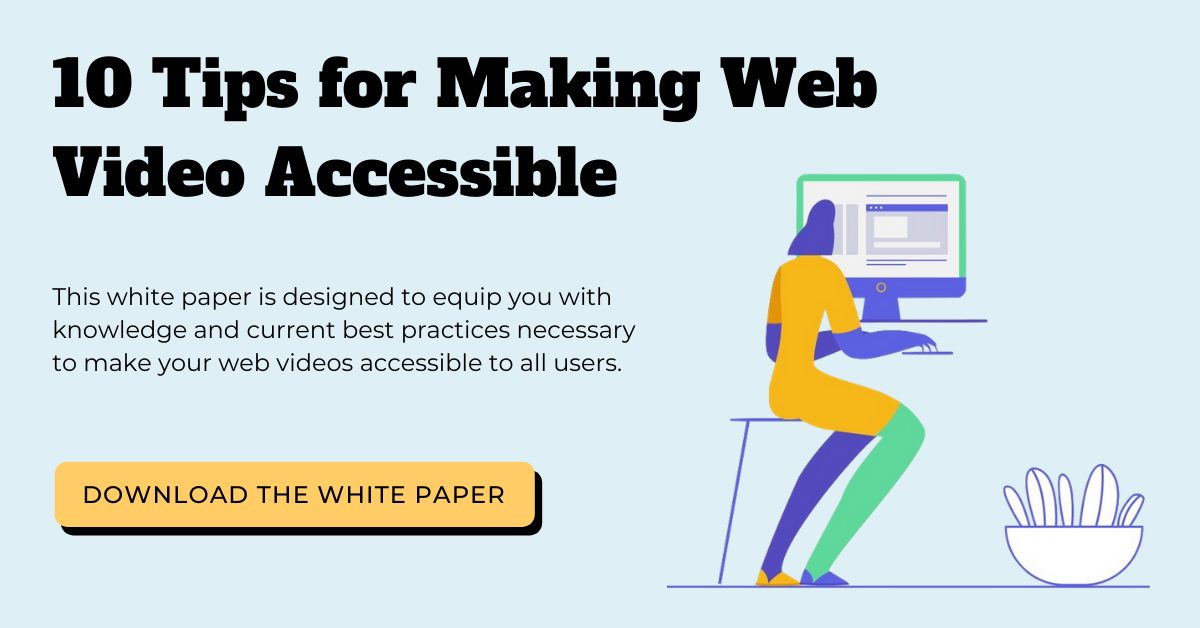Quick Guide to Real Estate Video Accessibility
Are you a real estate agent, broker, property manager, or someone in the real estate industry? You likely already know that websites are a valuable marketing tool and that real estate video content is an effective way to create an immersive and interactive experience for visitors.
However, it’s essential to provide accessible real estate videos to ensure access for all viewers.
Why Accessible Real Estate Video Content Matters
When it comes to browsing online real estate sites, videos tend to be more immersive and interactive than photos and text alone. Real estate video content could include live virtual tours with agents and prerecorded virtual walkthroughs (3D or non-3D) of properties.
In the case that you utilize real estate video marketing to reach potential customers, it’s crucial to include accessible video elements. In addition to providing access for people with disabilities, accessible video content can boost SEO, increase engagement, and create a better viewing experience.
Plus, your website may be legally required to comply with US accessibility laws.*
Accessibility
Accessible video ensures universal access to your real estate video content. Accessible video elements, such as transcripts, captions, and audio description, can help people with a range of disabilities, such as visual, auditory, physical, speech, cognitive, language, learning, and neurological disabilities.
Accessible video content also increases accessibility for viewers who are English language learners and those who speak English as a second language.
Legal Compliance
Real estate websites that aren’t compliant with accessibility laws could potentially be liable for lawsuits and fines.*
The Americans with Disabilities Act (ADA) requires all places of public accommodation to be accessible to those with disabilities. Public spaces must provide effective communication and equal access for all. While the ADA language doesn’t currently offer specific regulations for online accessibility, judges have ruled that the ADA applies to websites in many cases.
Some real estate companies that have been sued for lack of web accessibility include Zillow, Compass Real Estate, Zumper, Move, Inc., and CityRealty.com. The uptick in web accessibility suits may incentivize companies to implement accessible web design and content creation practices, including online real estate video content.
Companies can maintain best practices for video accessibility by adhering to Web Content Accessibility Guidelines (WCAG) – the international standard for web accessibility. In web accessibility lawsuits and cases, these guidelines are often referenced as a benchmark for accessibility, so it’s certainly a viable place to start.* WCAG calls for time-based media alternatives – such as online video, which includes captions, transcripts, and audio description.
SEO, Engagement, and Viewing Experience
Incorporating accessible video elements into your real estate video marketing strategy will improve SEO, engagement, and viewing experience.
Want to rise in search rankings? Contextual elements attached to media, like captions, transcripts, and audio description, help optimize your content for search engines.
Are you looking to boost engagement and provide a memorable viewing experience? Accessible video elements are proven to increase the number of views, enable viewing flexibility, and enhance brand recall.
How to Ensure Accessible Real Estate Video Content
Accessible video typically includes four elements: captions, transcripts, audio description, and an accessible video player.
To create an immersive experience for your real estate video marketing, your company may need to work with a third-party video accessibility solution to build a custom video player that supports all necessary accessibility features.
Captioning
Closed captions are a time-synchronized text file of the audio content. The captions display spoken dialogue, non-speech elements like sound effects or music, and speaker identification across the screen in text format as the video plays. This video feature is critical for deaf and hard of hearing individuals. People with neurological disorders and learning disabilities may also find it helpful to watch videos with captions.
Transcription
Transcription converts the dialogue and audio of a video into a written document and does not provide time-coded text like captions. Transcripts alone are not entirely accessible for most video content since they are not inherently time-based. With that said, transcripts do increase accessibility and are great to include in addition to captions.
Interactive transcripts are time-based, however. As the video plays, the spoken words are highlighted within the transcript. The viewer can then follow along with the text. Interactive transcripts also allow viewers to search for keywords within videos.
Audio Description
Audio description is the “verbal depiction of the key visual elements in media and live productions.” Video descriptions provide information on visual content that is considered essential to the comprehension of the program. This is particularly useful for viewers with visual impairments. However, it can also help people with autism and other neurological disorders, such as attention deficit disorder.
Are you ready to provide accessible and engaging real estate video content? Check out this guide that provides the top tips for making web video content accessible.
*DISCLAIMER: This blog post is written for educational and general information purposes only, and does not constitute specific legal advice. This blog should not be used as a substitute for competent legal advice from a licensed professional attorney in your state.
Further Reading

Subscribe to the Blog Digest
Sign up to receive our blog digest and other information on this topic. You can unsubscribe anytime.
By subscribing you agree to our privacy policy.










